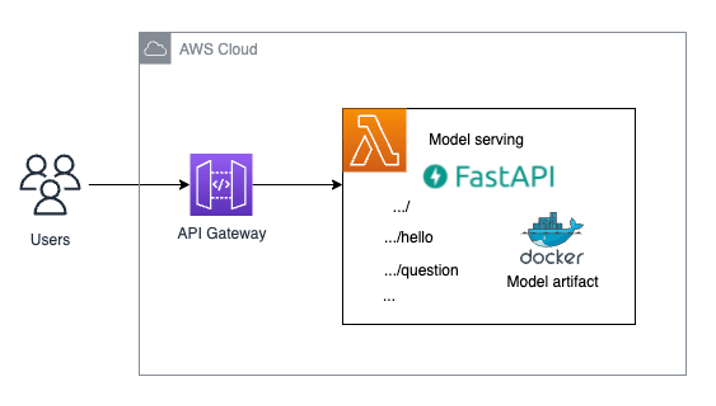Building Scalable APIs with FastAPI 🚀
Thursday, January 11, 2024
Introduction: Why FastAPI is a Great Choice for Modern APIs
So, why choose FastAPI over other frameworks? 🤔 Here are a few compelling reasons:
- Speed: FastAPI is built on standard Python type hints and leverages the ASGI (Asynchronous Server Gateway Interface) framework, making it one of the fastest Python frameworks available. ⚡️
- Robustness: FastAPI provides automatic interactive documentation, robust support for asynchronous programming, and built-in support for WebSockets.
- Ease of use: FastAPI has a low barrier to entry, making it an ideal choice for developers of all skill levels.
🛠️ Setting Up FastAPI: Installing and Creating a Basic API
Here is a basic diagram of how our applications it's going to look like

Getting started with FastAPI is straightforward. Here's a step-by-step guide:
Installing FastAPI
You can install FastAPI using pip:
pip install fastapi
Creating a Basic API
Create a new file called main.py and add the following code:
from fastapi import FastAPI
app = FastAPI()
@app.get("/")
def read_root():
return {"Hello": "World"}Run the application using:
uvicorn main:app --reload
Open your web browser and navigate to http://127.0.0.1:8000/ to see the API in action. 🎉
Optimizing Performance: Async Operations and Database Connections
One of the coolest things about FastAPI is its built-in async support. It’s perfect for handling things like database queries, external API calls, and any other tasks that don’t need to block the main thread.
Using Async Functions for Non-Blocking Execution:
You can use async and await to make sure your app doesn’t get stuck waiting for slow tasks. Here's a simple example:
@app.get("/items/{item_id}")
async def read_item(item_id: int):
return {"item": item_id}Connecting to Databases:
FastAPI works great with databases! Whether you’re using SQLAlchemy (PostgreSQL, MySQL) or MongoDB, it’s super easy to set up.
SQLAlchemy (PostgreSQL, MySQL):
from sqlalchemy import create_engine from sqlalchemy.orm import sessionmaker DATABASE_URL = "postgresql://user:password@localhost/dbname" engine = create_engine(DATABASE_URL) SessionLocal = sessionmaker(autocommit=False, autoflush=False, bind=engine)
MongoDB with Motor (MongoDB’s async driver):
from motor.motor_asyncio import AsyncIOMotorClient
client = AsyncIOMotorClient("mongodb://localhost:27017")
db = client.mydatabaseAuthentication & Security
Security is super important, and FastAPI makes it easy to add authentication and protect your APIs. 🛡️
JWT Authentication:
JSON Web Tokens (JWT) are a popular way to securely transmit information between the client and server.
from fastapi.security import OAuth2PasswordBearer
oauth2_scheme = OAuth2PasswordBearer(tokenUrl="token")
@app.get("/users/me")
async def read_users_me(token: str = Depends(oauth2_scheme)):
return {"token": token}OAuth2 Authentication (Github Example):
FastAPI lets you integrate OAuth2 with third-party providers like Google, GitHub, and more. Easy peasy!
from fastapi import FastAPI, Depends, HTTPException
from fastapi.security import OAuth2PasswordBearer, OAuth2PasswordRequestForm
from pydantic import BaseModel
import requests
import json
app = FastAPI()
oauth2_scheme = OAuth2PasswordBearer(tokenUrl="token")
class User(BaseModel):
username: str
email: str
class Token(BaseModel):
access_token: str
token_type: str
@app.post("/token")
async def login(form_data: OAuth2PasswordRequestForm = Depends()):
# Change it for your credentials
client_id = "your_client_id"
client_secret = "your_client_secret"
code = form_data.password
# Exchange authorization code for access token
token_url = "https://github.com/login/oauth/access_token"
headers = {"Accept": "application/json"}
data = {"client_id": client_id, "client_secret": client_secret, "code": code}
response = requests.post(token_url, headers=headers, data=data)
if response.status_code != 200:
raise HTTPException(status_code=401, detail="Invalid credentials")
# get the access token from the response
access_token = response.json()["access_token"]
# use the access token to get the user's information
user_url = "https://api.github.com/user"
headers = {"Authorization": f"Bearer {access_token}"}
response = requests.get(user_url, headers=headers)
# check if the response was successful
if response.status_code != 200:
raise HTTPException(status_code=401, detail="Invalid credentials")
# get the user's information from the response
user_data = response.json()
username = user_data["login"]
email = user_data["email"]
# return the access token and user information
return {"access_token": access_token, "token_type": "bearer", "username": username, "email": email}Rate Limiting
You can use rate limiting to prevent abuse:
# Simple rate limiter
rate_limiter: Dict[str, int] = {}
def is_rate_limited(ip_address: str) -> bool:
if ip_address in rate_limiter:
if rate_limiter[ip_address] >= 5:
return True
else:
rate_limiter[ip_address] += 1
else:
rate_limiter[ip_address] = 1
return False
# use case
if is_rate_limited(ip_address):
raise HTTPException(status_code=429, detail="Too many requests")Deployment
You can deploy FastAPI using docker:
- Create docker file
FROM python:3.9-slim WORKDIR /app COPY requirements.txt . RUN pip install -r requirements.txt COPY . . CMD ["uvicorn", "main:app", "--host", "0.0.0.0", "--port", "8000"]
- Run & build a docker container
docker build -t fastapi-app . docker run -p 8000:8000 fastapi-app
- Deploy to AWS Lambda
Want to go serverless? FastAPI works perfectly with AWS Lambda. You can use Mangum, a lightweight adapter to run FastAPI with Lambda.
First, let's install Mangum
pip install mangum
And here's how you can use it:
from fastapi import FastAPI, Request
from mangum import Mangum
app = FastAPI()
@app.get("/")
def read_root():
return {"Hello": "World"}
handler = Mangum(app)
def lambda_handler(event, context):
return handler(event, context)And that's it, remember to add create your requirements.txt file!